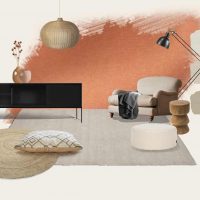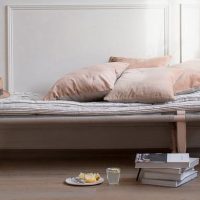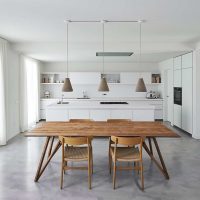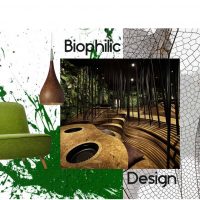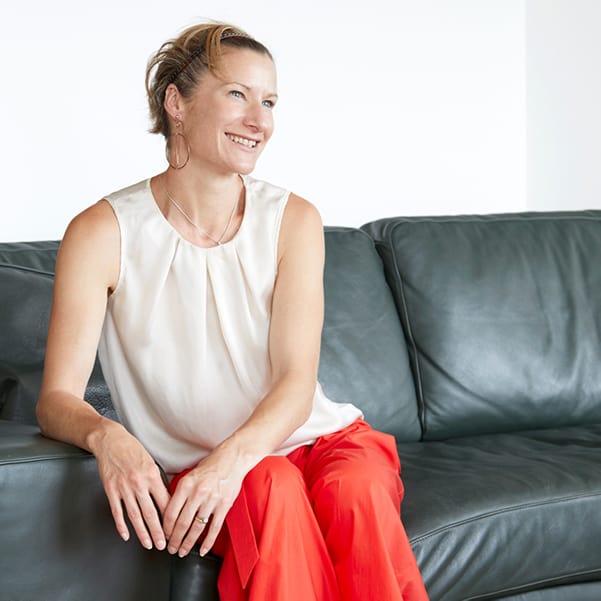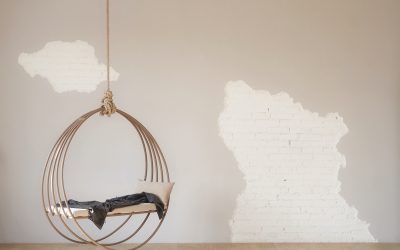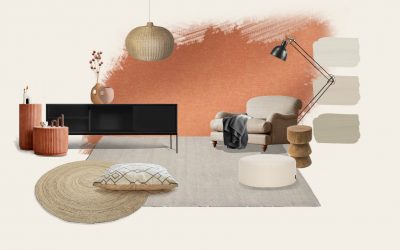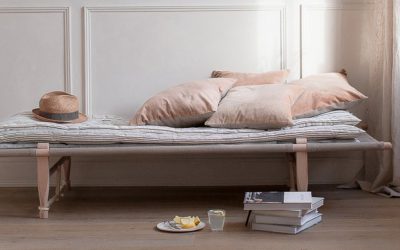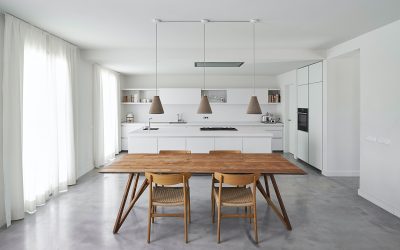What’s the difference between Sustainable, Biophilic, and Vegan Design?
I managed to get myself embroiled in a LinkedIn debate questioning the use of animal products in Biophilic interiors. There were strong opinions and valid points from both camps raised, so in the end, I decided it best to draw a conclusion based on some research. What is the overlap between sustainable, biophilic and vegan interior design?
I have already written a Blog about Biophilic design and the majority of us are well versed in sustainable practices whether we live by them or not, but Vegan Interior design is also a rapidly evolving movement.
Biophilic – meaning love of nature

This focuses on human’s innate attraction to nature and natural processes. Coined by the psychologist Erich Fromm in 1964 he described it as “the passionate love of life and all that is alive”. It suggests that we all have a genetic connection to the natural world built up through hundreds of thousands of years of living in agrarian settings. Essentially Biophilic Design is the incorporation of nature and natural elements, materials and forms into architecture and interiors.
There are a number of factors that combine to form the overall principles of Biophilic Design. Elements such as Natural Lighting and Air; Planting; Natural Materials; Naturalistic Shapes and Forms; Biomimicry and Cultural Identity all merging to play a roll in encouraging human engagement within the natural world.
Vegan interior design

This is possibly a more puritan version of biophilic design. this broad concept means that all finishes, fittings and furniture must not negatively affect animals or contain any harmful components. Vegan design affects the materials that we use and goes even further to promote ways of living in harmony with other living creatures, without damaging the environment. This is what is known as “cruelty-free”.
More and more consumers are wakening up to the devastating impact of meat farming on the environment. The meat and dairy industries account for 60 per cent of global greenhouse gas emissions. If we take animal products out of our diet, and out of our homes and workplaces, we can reduce our carbon footprint by a whopping 73 per cent. Vegan designer Erez Nevi Pana, wrote an article in Dezeen (12 Feb 2019) expressing how other designers should follow in his footsteps to help solve the problems facing the world. “We need to question the approach to design and to the world that places humans in the centre. It’s about time that animals and the planet are placed alongside humans – a shift towards a more holistic approach”.
Indeed vegan interior design is becoming more mainstream, in January 2019 designers Bompas and Parr created the world’s first vegan hotel room in London’s, Hilton, Bankside Hotel. The interior design of the room avoids all leather, feathers and wool. It instead relies heavily on Piñatex, an innovative leather-like material made from the cellulose fibre in pineapple leaves. While Mercedes has been selling vehicles entirely free of leather since 2016.

There are however a number of issues associated with vegan design as it stands today. Firstly, the industry is blended within brands that use animal products. Second, it’s still quite a small elite market, vegan solutions for basic materials such as high-strength natural adhesives, leather alternatives and plant-based fabrics are just coming in or being invented resulting in a more expensive product or finish. In order to make significant progress, vegan alternatives must be affordable and accessible for the investors, while retaining its appeal to a broader range of consumers. As designers it has become our duty to influence these changes, ultimately the power of change is in the hands of the consumer. If their need for vegan products rises then more and more will be produced and ultimately result in greater affordability.
The counter argument comes in from Sabastian Cox ( Dezeen 1 March 2019) According to his thinking “…by seeking out and scandalising every animal-derived product, we could be at best distracting ourselves from bigger issues, and at worst inadvertently causing ecological problems. Ecology is complex, and not suited to simplistic binary solutions. Nature itself is not vegan, so to become vegan is to step out of the system we evolved in, at a time where we need to be getting closer to it”. The basis of his thinking lays along the lines of rewilding, this holistic thinking is to consider the balance between the herbivores and predators that evolved in a particular landscape. Grazers or browsers stimulate new plant growth and predators are needed to keep their numbers in check, or move them on, to prevent overgrazing.
Cox goes on to state “ I only eat meat that comes from diverse pasture or wild landscapes, for example, the beef I eat comes from a company founded by a young couple who rear ancient breed cattle on upland scrub and woodland, borrowed or rented from local landowners. The herd’s winter diet is mostly bramble, bracken, and young tree shoots; no grain here. They are hardy enough to survive outside year-round and require little in the way of veterinary attention. These ancient breeds can carry 230 different types of wildflower seeds in their fur and gut, some of which have evolved to only be distributed by grazing mammals. The seeds they spread form the basis of diverse food chains, which is the kind of impact we need to bolster populations of rare species.
 This is one of those difficult topics to confront, while most of us recognise the issues at hand, not everyone is in agreement as to how it should be tackled and not everyone is in a position to address it. While some live in a privileged society where we have reached a certain standard that we expect to maintain, others are still struggling to keep up with the basics and this divide is only becoming ever wider. My take out would be that while living more Sustainability may be the overall goal, Biophilic design is an achievable standard however it needs to push the benchmark further than merely painting walls green, sticking in plants and adding in a timber finish! Alternatively, Vegan design may be the gold standard, but for the main part, it has not been developed far enough at this stage, therefore remaining out of reach for the majority.
This is one of those difficult topics to confront, while most of us recognise the issues at hand, not everyone is in agreement as to how it should be tackled and not everyone is in a position to address it. While some live in a privileged society where we have reached a certain standard that we expect to maintain, others are still struggling to keep up with the basics and this divide is only becoming ever wider. My take out would be that while living more Sustainability may be the overall goal, Biophilic design is an achievable standard however it needs to push the benchmark further than merely painting walls green, sticking in plants and adding in a timber finish! Alternatively, Vegan design may be the gold standard, but for the main part, it has not been developed far enough at this stage, therefore remaining out of reach for the majority.
The design world is defiantly taking a turn in the right direction when it comes to creating environments that benefit not only the end-user but our planet also. It has to start with small steps, with individual trailblazers and larger corporate companies changing the way they work. If more and more individuals and companies begin to march in the same direction and hold hands, the tide to making the kind of large scale changes required to become possible and can only get stronger. For some, the belief that animals are too precious to be used for our gain is foremost in their thinking, for which there is a very strong argument. For others their belief holds that historically humans have used animals for food, shelter, tools and clothing and therefore hold no issue with continuing in this line, however, they acknowledge that the process needs to be questioned and radically altered to make it more sustainable; less meat, fewer animal bi-products, less factory processing etc. Whatever your belief system is, we all need to agree that we can win through strength in numbers as we strive to achieve the same end goal. Why rather than pulling the higher moral ground don’t we all pull together and work towards a safer more sustainable system.
I have no doubt but these debates will continue but I am willing to learn and evolve and I hope this movement can only grow as we all stand our ground together and demand a better way.
If you want to know how to create a sustainable interior design scheme including all materials, finishes and recommended suppliers then see our full guide by following the link below.
Also if you would like to know more about Biophilic Interior design and specifically how to incorporate it into you home interior then have a look at this article.
At Yellow Brick Road Design – Devon-based Domestic Interior Design and Commercial Interior Design & Project Management, we love to push the boat out on both our Commercial Interior Design and Domestic Interior Design Projects. We look forward to forging new relationships and we aim to work with all of our clients to create that individual space that will help them stand out from the crowd.

